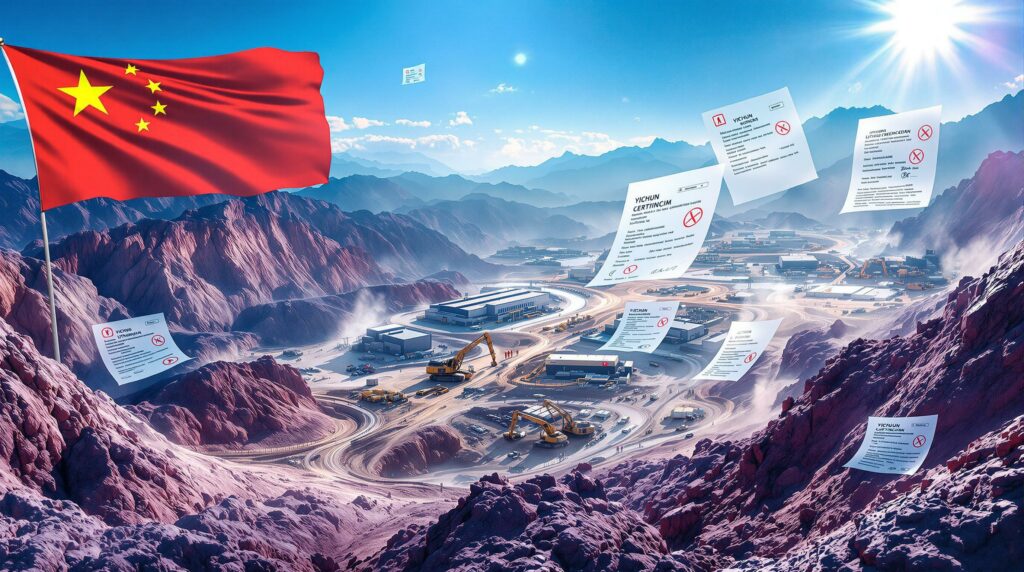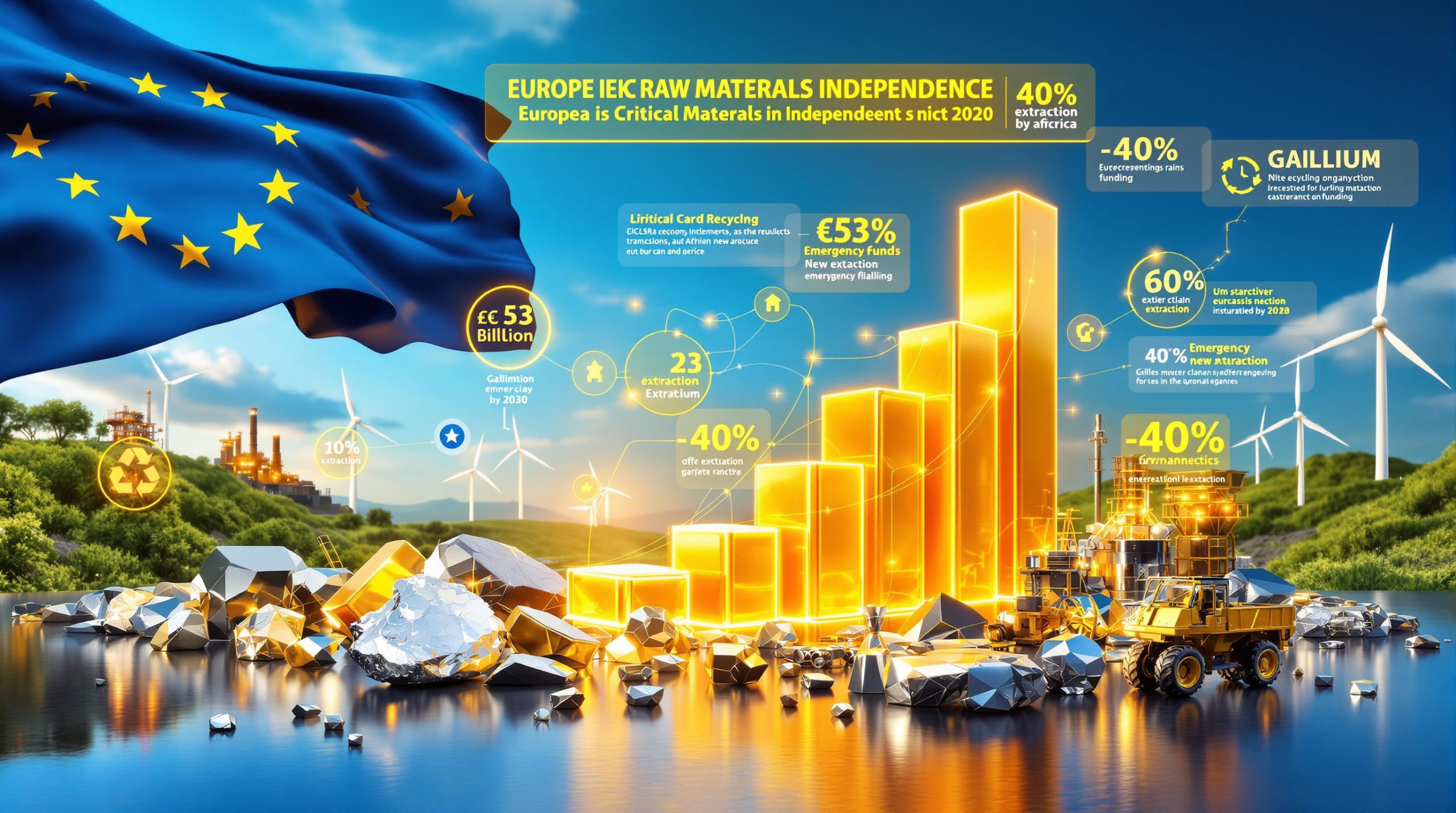Regulatory Challenges in China's Lithium Hub: Understanding Permit Issues in Yichun
In a significant development for China's lithium industry, regulatory authorities have identified permit discrepancies at eight lithium mines in Yichun, a city known as China's "lithium capital." This regulatory action represents the latest move in Beijing's broader effort to bring order to its rapidly expanding lithium supply chain, with potentially far-reaching implications for global lithium markets.
What's Happening with Mining Permits in China's "Lithium Capital"?
The Yichun Natural Resources Bureau has issued notices to eight lithium mining operations, requiring them to submit resource reserve verification reports due to discrepancies between their licensed mining rights and the actual minerals being extracted. This enforcement action mirrors similar measures taken in other regions and forms part of a nationwide push to eliminate illegal mining practices.
Recent Regulatory Actions in Yichun
The regulatory scrutiny in Yichun centers on permit compliance and proper documentation. Officials are examining whether mining activities align with approved licenses, focusing particularly on:
- Verification of resource reserves
- Alignment between licensed mining rights and actual extraction
- Compliance with environmental standards
- Adherence to production quotas and reporting requirements
This oversight comes as China seeks to better manage its strategic mineral resources amid surging demand from the electric vehicle sector.
Context of the Broader Regulatory Crackdown
The Yichun situation isn't occurring in isolation. Similar enforcement actions have taken place in Qinghai province, where authorities halted operations at Zangge Mining in Haixi Prefecture until proper lithium extraction permits could be obtained. The issue in Qinghai highlights a common problem—many resource extraction activities across the province's salt lakes are licensed for minerals such as potash, not lithium.
"This is part of a broader regulatory push to curb illegal mining practices and bring greater discipline to the lithium supply chain, which has been expanding so rapidly in recent years that it even outpaced demand from the electric vehicle industry," noted industry observers cited in the MINING.com report.
Such actions reflect Beijing's determination to standardize practices across its critical minerals sector while ensuring that rapid industry expansion doesn't compromise resource management or environmental standards.
Why is Yichun Important to China's Lithium Industry?
Yichun has emerged as a crucial hub in China's lithium landscape, with its significance extending beyond mere production volume to encompass strategic advantages in location and accessibility.
Strategic Significance of Yichun
Dubbed the "lithium capital" of China, Yichun holds a significant share of the country's lithium output. The region's importance stems from several factors:
- Rich lepidolite deposits: The area contains substantial reserves of lepidolite, a lithium-bearing rock that serves as a primary source for battery-grade lithium materials
- Processing advantages: The mineral composition allows for relatively efficient extraction compared to some other lithium sources
- Geographic accessibility: Unlike remote brine operations, Yichun's resources are located in a more accessible eastern region
- Infrastructure connectivity: Established transportation networks facilitate movement of raw materials and finished products
What makes Yichun particularly valuable is its relative proximity to China's manufacturing centers. Compared to the brine lakes on China's western plateaus and the spodumene rock in southwestern Sichuan province, Yichun's lepidolite-rich mountains are more accessible to battery makers, creating logistical advantages throughout the supply chain.
Investment Landscape in the Region
The strategic value of Yichun has not gone unnoticed by industry players. Hundreds of key companies in the electric vehicle sector have invested in the area, establishing a robust ecosystem of extraction, processing, and manufacturing operations. Major industry leaders including CATL (Contemporary Amperex Technology Co. Limited) and Gotion High Tech have made significant investments in the region.
These investments have created an integrated industrial cluster that connects upstream mining with downstream battery production, reinforcing Yichun's position as a linchpin in China's lithium supply chain and critical minerals strategy.
What Are the Underlying Permit Issues?
The regulatory challenges in Yichun stem from fundamental discrepancies between official permits and actual mining activities, reflecting the rapid and sometimes disorderly growth of China's lithium industry.
Types of Regulatory Discrepancies
While specific details of each case vary, the permit issues in China's lithium capital generally fall into several categories:
- Mineral classification mismatches: Mining for minerals not explicitly covered in existing permits
- Boundary violations: Potential extraction beyond authorized geographical limits
- Documentation inadequacies: Insufficient or outdated resource verification reports
- Production reporting discrepancies: Differences between reported and actual extraction volumes
These issues reflect the challenges of maintaining regulatory oversight in a sector experiencing explosive growth driven by electric vehicle demand. The requirement for resource reserve verification reports suggests authorities are working to establish a more accurate baseline of actual extraction activities before determining appropriate remedial measures.
Comparison to Qinghai's Regulatory Issues
The situation in Yichun bears notable similarities to regulatory actions in Qinghai province, though with important distinctions. In Qinghai, many operations held permits for potash extraction but were actually producing lithium—a clear classification mismatch. This led to the shutdown of Zangge Mining's operations pending proper lithium extraction permits.
The key differences between the regions include:
- Mineral source: Qinghai primarily extracts lithium from salt lake brines, while Yichun focuses on lepidolite rock
- Geographical context: Qinghai operations are located in remote western regions, while Yichun sites are more accessible
- Industrial integration: Yichun's operations are more directly integrated with downstream battery manufacturing
These regional variations influence how regulatory enforcement unfolds, though the underlying principle remains consistent: ensuring all lithium extraction occurs under proper licensing and oversight.
How Does This Fit into China's Broader Resource Strategy?
China's actions in Yichun represent more than localized regulatory enforcement—they reflect a comprehensive national approach to managing critical mineral resources in alignment with industrial policy objectives.
National Control of Critical Minerals
The regulatory measures in Yichun and elsewhere demonstrate China's determination to exercise greater control over its lithium resources. This strategy encompasses:
- Supply chain security: Ensuring domestic lithium resources are properly documented and regulated
- Quality standardization: Implementing consistent extraction and processing standards
- Environmental protection: Minimizing ecological impacts through proper oversight
- Resource conservation: Preventing wasteful or inefficient extraction practices
- Strategic reserve management: Maintaining appropriate stockpiles of critical materials
These efforts align with China's broader goals of dominating the electric vehicle supply chain while ensuring sustainable development of its mineral resources. By bringing greater discipline to lithium extraction, authorities aim to create a more stable and resilient supply base for the country's growing battery industry.
Supply Chain Implications
The regulatory actions also serve supply chain management objectives that extend beyond mere compliance:
- Production rationalization: Addressing potential overproduction by ensuring all extraction occurs within approved parameters
- Market stabilization: Removing irregular market participants to create more predictable supply conditions
- Quality assurance: Ensuring lithium products meet the high standards required for advanced battery applications
- Domestic prioritization: Securing critical mineral supplies for China's own manufacturing base before export markets
According to analysis cited by Founder Securities, these measures will "help the industry clean up excess supply," suggesting the regulatory enforcement serves both compliance and market balancing objectives.
What Market Impact Has Resulted from These Regulatory Actions?
The regulatory actions in Yichun have triggered notable market responses, with immediate price movements suggesting significant implications for lithium supply-demand dynamics.
Immediate Price Reactions
News of the permit issues and potential production disruptions sparked rapid market movements:
- Lithium carbonate futures hit the daily upper limit, closing with a gain of over 7%
- Prices reached their highest level since March 2025
- Shares of lithium miners jumped significantly on Chinese exchanges
- Trading volumes increased substantially as market participants repositioned
These price reactions reflect the market's assessment that the regulatory measures could meaningfully impact available lithium supplies, at least in the short term. The sharp movements also suggest that traders had not fully priced in regulatory risk prior to the announcements.
Long-Term Market Outlook
Beyond immediate price volatility, analysts have identified potential longer-term implications of the regulatory enforcement:
- Temporary production disruptions: Some mines may face production suspensions during compliance verification
- Industry rationalization: Irregular or non-compliant producers may exit the market
- Supply stabilization: Removal of excess capacity could bring supply more in line with demand
- Quality improvements: Stricter oversight may lead to more consistent product specifications
While enforcement actions in Yichun could temporarily disrupt production, many analysts believe it may also help remove irregular players and stabilize the sector over the long term. This perspective suggests the short-term price increases may moderate as the market adjusts to a more regulated but potentially more predictable supply environment.
How Does Lepidolite Mining in Yichun Compare to Other Lithium Sources?
Understanding Yichun's significance requires examining how its lepidolite-based lithium production compares to alternative sources, each with distinct characteristics affecting cost, environmental impact, and supply chain logistics.
Lepidolite vs. Other Lithium Sources
Lepidolite represents one of several commercially viable lithium sources, each with unique properties:
| Lithium Source | Typical Li Content | Processing Complexity | Environmental Considerations | Geographic Distribution |
|---|---|---|---|---|
| Lepidolite (Yichun) | 1.0-1.5% | Moderate | Water usage for processing, chemical waste management | Eastern China |
| Spodumene | 1.5-7.5% | High (requires high-temperature conversion) | Energy-intensive, acid usage | Australia, Western China |
| Brine | 0.04-0.15% | Low (but lengthy extraction time) | Large land footprint, water evaporation | South America, Western China |
| Clay | 0.1-0.4% | Moderate to high | Water usage, potential acid leaching | U.S., Mexico |
Lepidolite processing typically requires roasting and leaching to extract lithium, with processing costs generally higher than brine operations but lower than some hard-rock alternatives. While not containing the highest lithium concentration, lepidolite's accessibility and established processing methods make it an attractive source for China's growing battery industry.
Geographical Advantages
Yichun's lepidolite resources enjoy several geographical advantages compared to alternative sources:
- Proximity advantage: Located closer to battery manufacturing centers than western brine operations
- Infrastructure access: Well-developed transportation networks for moving materials
- Processing efficiency: Established local processing capabilities reduce logistics costs
- Workforce availability: Access to skilled labor for both mining and processing operations
- Utility connections: Reliable power and water supplies for processing operations
These geographical factors help explain why Yichun has attracted significant investment despite having lower lithium concentrations than some alternative sources. The combination of resource availability and logistical advantages creates compelling economics that have supported the region's rapid development as a lithium hub.
What Are the Potential Outcomes of These Regulatory Actions?
The regulatory scrutiny in Yichun could lead to various outcomes depending on compliance levels, government priorities, and market conditions.
Scenarios for Affected Mines
For the eight mines identified with permit issues, several potential paths exist:
- Temporary suspension: Operations paused during verification process with resumption after documentation is updated
- Permit modifications: Adjustment of existing permits to properly cover actual extraction activities
- Operational restrictions: Limitations on production volumes or extraction areas
- Ownership changes: Acquisition of non-compliant operations by larger, compliant entities
- Complete closure: Shutdown of operations with serious or irremediable violations
The most likely scenario involves temporary suspensions while verification processes are completed, followed by permit adjustments and resumption of operations under enhanced monitoring. However, operations found to have significant violations may face more severe consequences.
Industry Restructuring Possibilities
Beyond individual mine impacts, the regulatory actions could catalyze broader industry consolidation moves:
- Consolidation acceleration: Smaller operators may find compliance costs prohibitive, leading to acquisition opportunities
- Entry barrier elevation: Higher compliance standards may discourage speculative new entrants
- Technology upgrades: Requirements for better documentation may drive investment in monitoring technologies
- Formalization of processes: More standardized operating procedures across the industry
- Transparent reporting: Enhanced disclosure requirements for production volumes and reserves
These potential outcomes align with the assessment from Founder Securities that the measures will help "clean up excess supply" and potentially stabilize the sector over the long term. The result could be a more mature, regulated industry with fewer but more compliant participants.
How Should Stakeholders Respond to These Developments?
The regulatory changes in Yichun create both challenges and opportunities for various stakeholders across the lithium supply chain, requiring thoughtful strategic responses.
Considerations for Mining Companies
Mining operators in China's lithium sector should consider several response strategies:
- Proactive compliance audits: Reviewing all permits and actual operations to identify potential discrepancies
- Documentation enhancement: Ensuring resource reserve reports and other technical documentation meet current standards
- Transparent disclosure: Providing clear information to investors and partners about regulatory status
- Operational adjustments: Aligning extraction activities precisely with permit parameters
- Engagement with authorities: Establishing constructive dialogue with regulatory officials
Disclaimer: Mining companies should consult with legal experts familiar with Chinese mining permit basics before implementing specific compliance measures. Regulatory requirements may vary by location and are subject to change.
Companies that address compliance issues proactively may avoid prolonged shutdowns and position themselves advantageously as the industry consolidates around more disciplined operators.
Investor Implications
For investors with exposure to China's lithium sector, the regulatory developments warrant careful consideration:
- Due diligence enhancement: Investigating the permit status of portfolio companies
- Risk assessment: Evaluating geographical concentration and regulatory exposure
- Volatility preparation: Anticipating continued price fluctuations as enforcement actions unfold
- Opportunity identification: Considering well-established operators with strong compliance records
- Long-term perspective: Looking beyond short-term disruptions to potential industry rationalization benefits
While short-term volatility is likely, investors who can navigate the transition period may benefit from a more stable and transparent market environment once regulatory adjustments are complete.
Frequently Asked Questions About China's Lithium Regulation
Common Questions About the Regulatory Actions
Will these regulations significantly impact global lithium supply?
While temporary disruptions are possible, the global impact will depend on the duration of suspensions and whether similar enforcement spreads to other regions. China's domestic market may absorb most of the impact initially.
How long might affected mines remain suspended?
Based on previous regulatory halt examples, verification processes typically take between several weeks to a few months, though complex cases may require longer resolution periods.
Are other lithium-producing regions in China facing similar scrutiny?
Given the precedents in both Yichun and Qinghai, it appears regulatory authorities are implementing nationwide standards, suggesting other production regions may face similar reviews.
What documentation is required to resolve permit discrepancies?
At minimum, operators must provide resource reserve verification reports. Additional requirements may include environmental impact assessments, safety documentation, and production records.
How will this affect China's position in the global lithium market?
While short-term disruptions may occur, the enhanced oversight likely strengthens China's long-term position by creating a more sustainable and reliable supply base for its domestic battery industry.
Technical Questions About Compliance Requirements
What specific permit types are required for lithium extraction?
Permits must specifically authorize lithium extraction, even if operations previously held permits for other minerals. Classification accuracy is critical for compliance.
How do verification processes work for resource reserves?
Verification typically involves independent technical assessment of deposit characteristics, extraction methodologies, and reserve calculations according to national standards.
What environmental standards must be met?
Requirements include water usage monitoring, waste management plans, land reclamation provisions, and ecological impact mitigation measures specific to the mining method used.
Conclusion: A Turning Point for China's Lithium Industry
The regulatory actions in Yichun represent a significant evolution in China's approach to managing its critical mineral resources. By addressing permit discrepancies and bringing greater discipline to lithium extraction, authorities aim to create a more sustainable, transparent, and reliable supply chain for this essential battery material.
While short-term disruptions and price volatility are inevitable, the long-term outcomes may ultimately benefit compliant operators and contribute to market stability. As China continues to refine its oversight of strategic minerals, stakeholders throughout the global lithium supply chain will need to adapt to a more regulated but potentially more predictable operating environment.
Furthermore, these regulatory actions could serve as a template for future executive orders on permits in other jurisdictions as governments worldwide recognize the strategic importance of securing reliable supplies of battery minerals.
Disclaimer: This article contains analysis of regulatory developments and market conditions that may change rapidly. Information provided is for educational purposes only and should not be considered investment advice. Readers should conduct their own research and consult with professional advisors before making investment decisions related to the lithium sector.
Wondering How to Stay Ahead of Major Mineral Discoveries?
Discover significant ASX mineral announcements the moment they happen with Discovery Alert's proprietary Discovery IQ model, giving you the advantage to act on investment opportunities before the market. Visit the discoveries page to see how historic discoveries have generated substantial returns for early investors.




